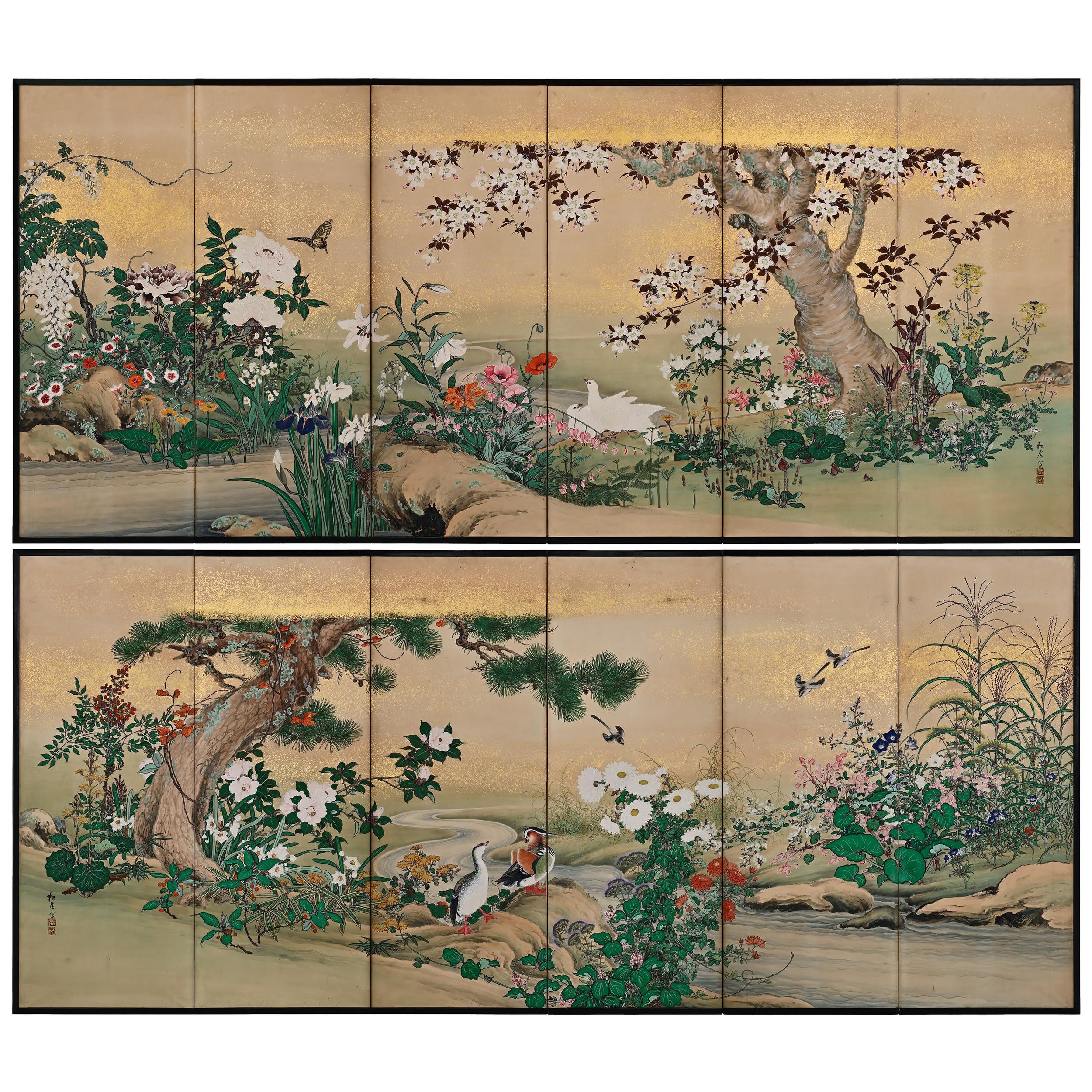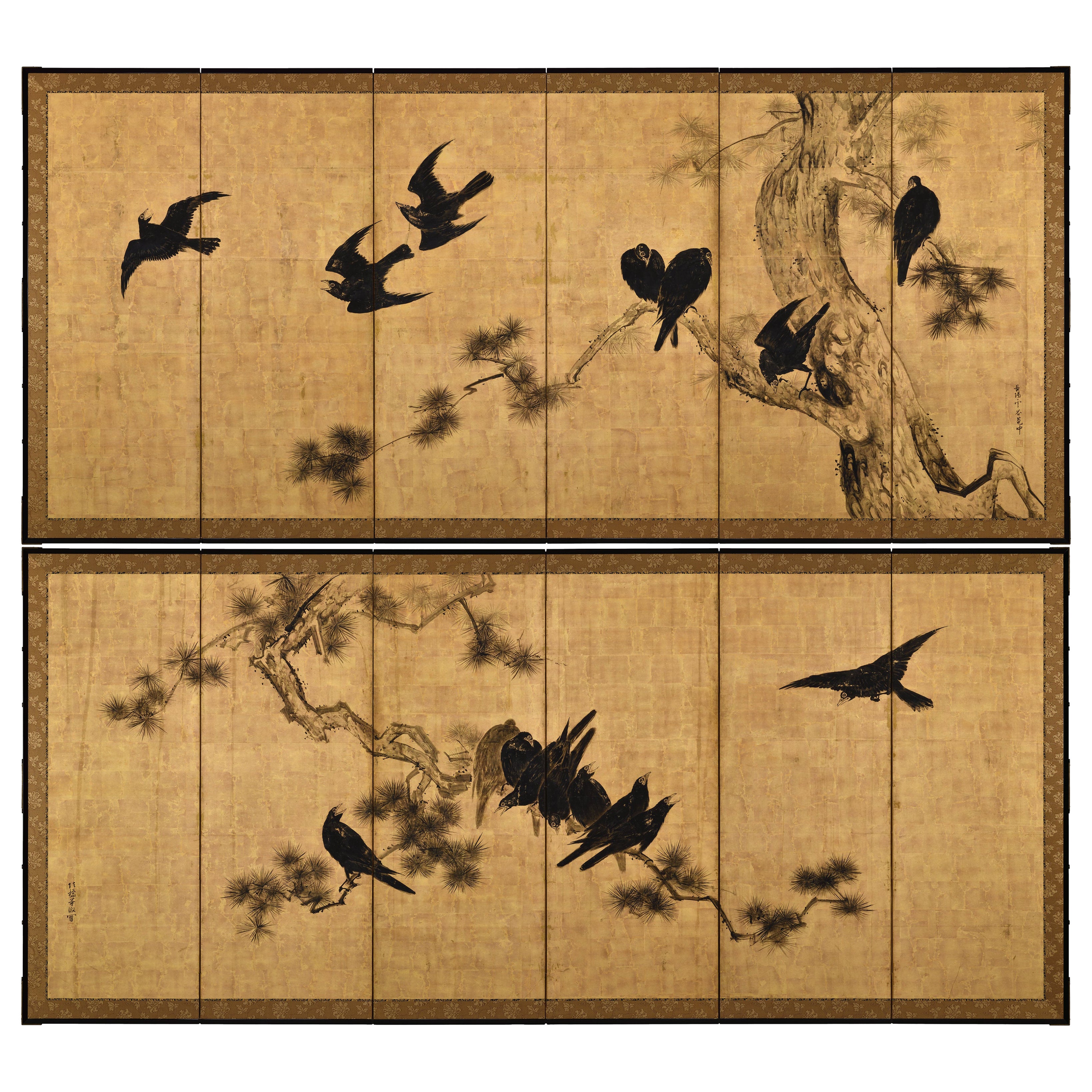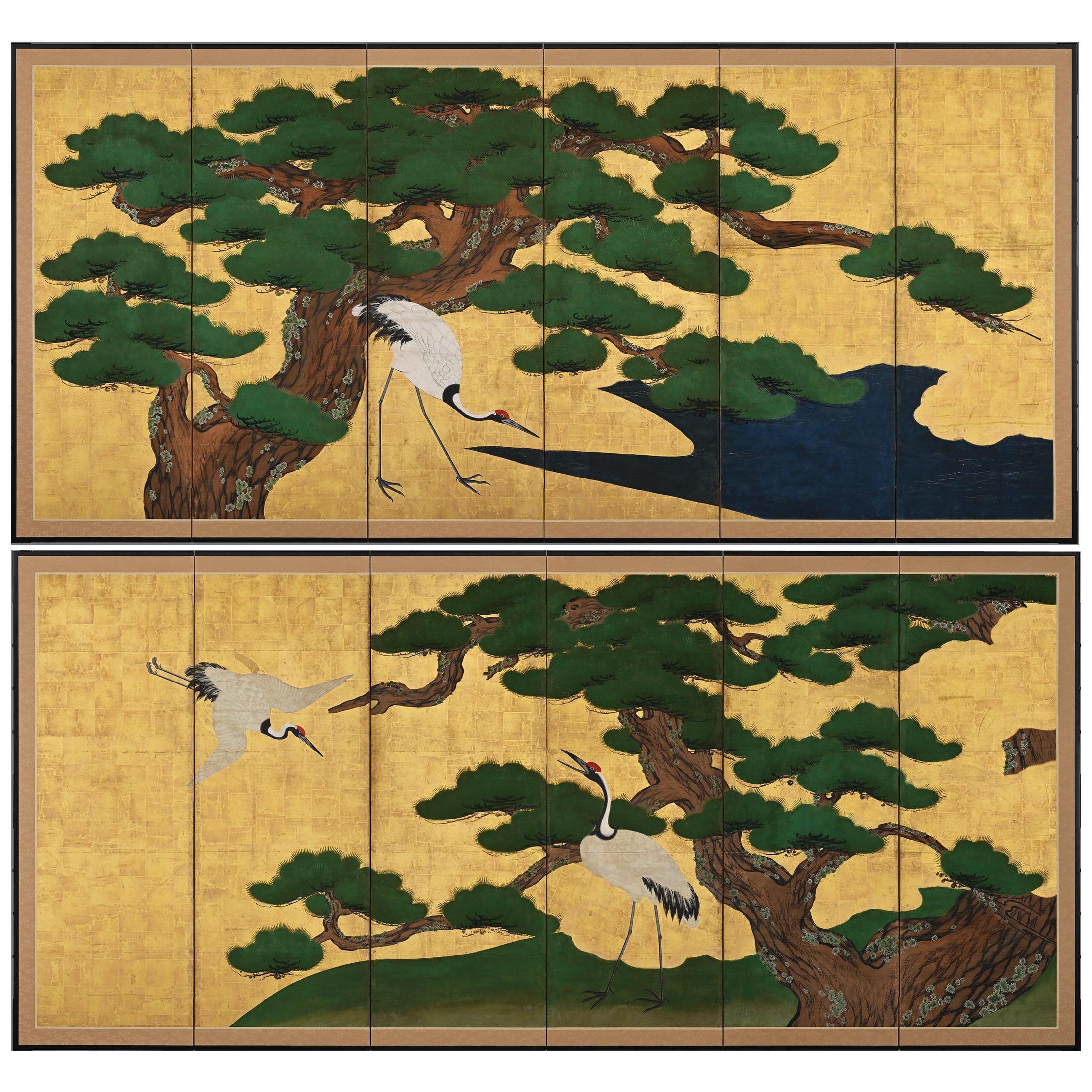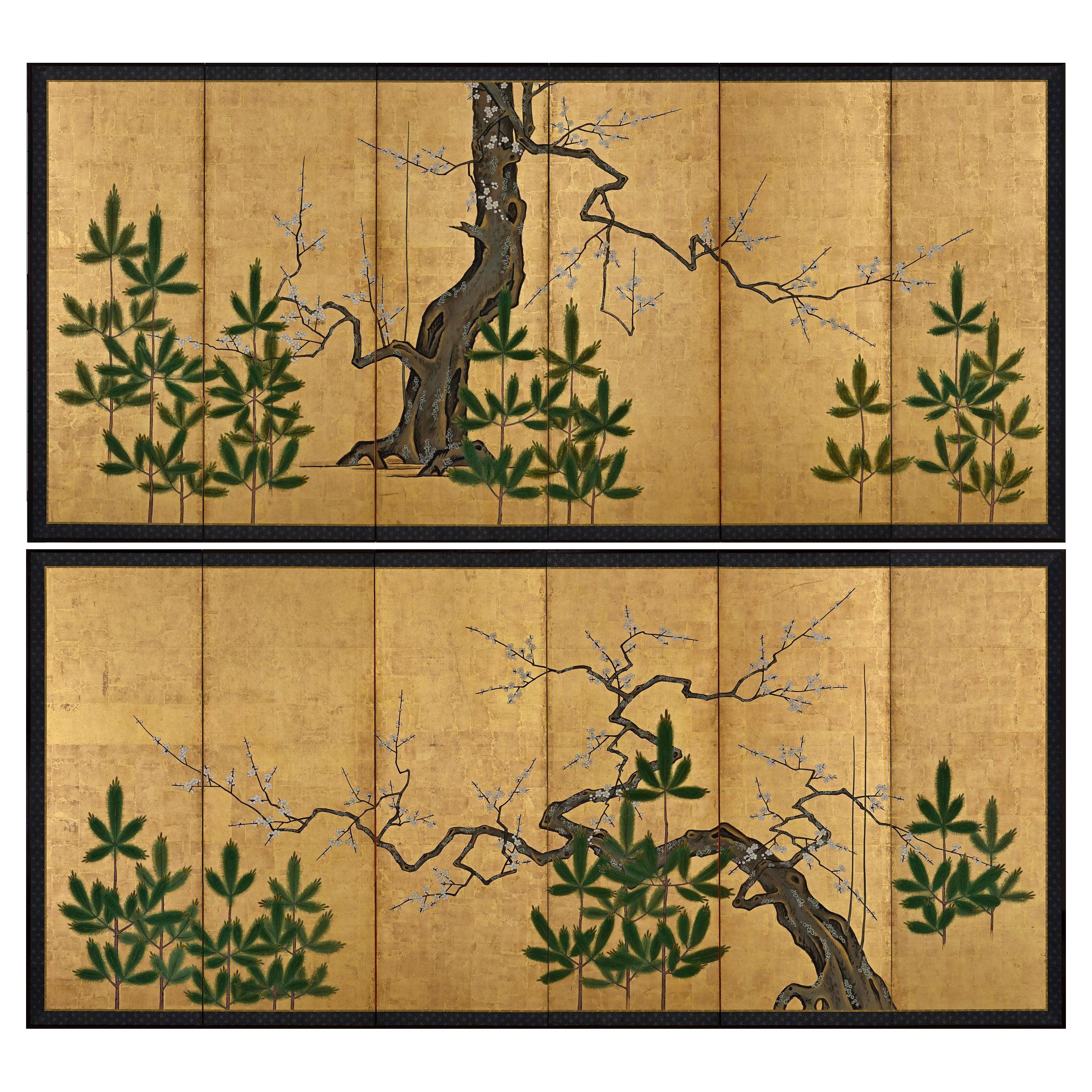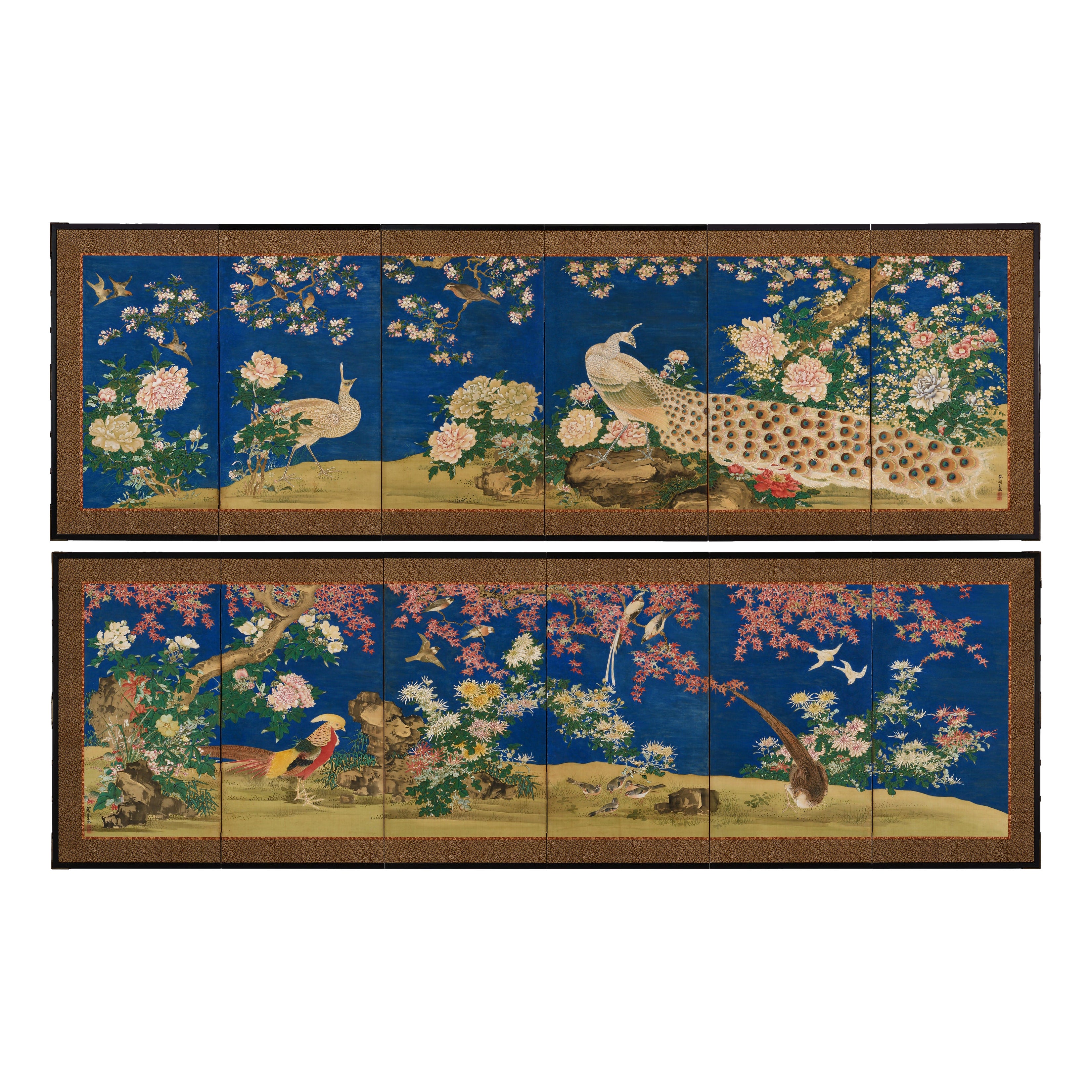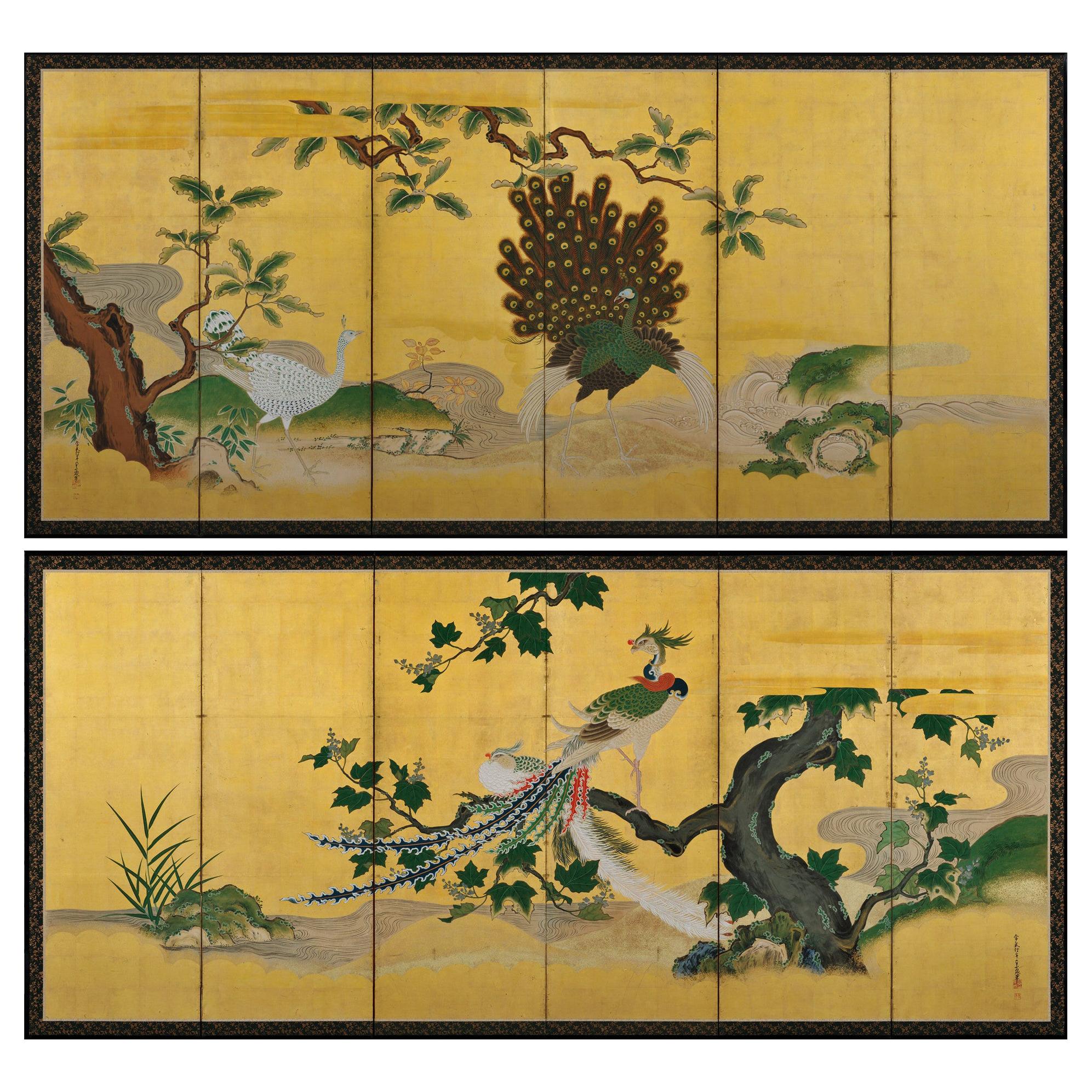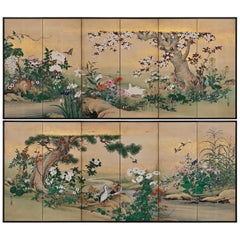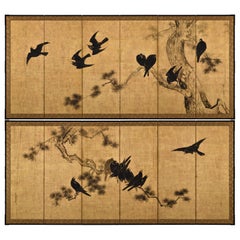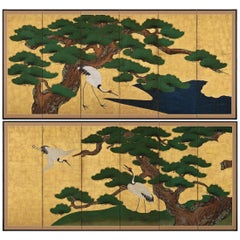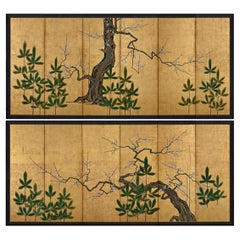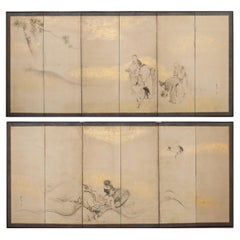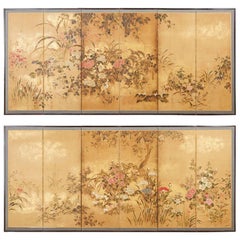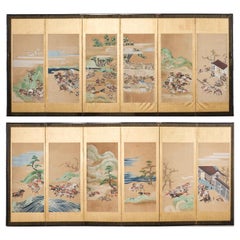Items Similar to 17th Century Japanese Screen Pair by Soga Nichokuan, Hawks on Pine & Plum Trees
Want more images or videos?
Request additional images or videos from the seller
1 of 13
17th Century Japanese Screen Pair by Soga Nichokuan, Hawks on Pine & Plum Trees
$85,000per set
£63,225.63per set
€74,024.72per set
CA$118,603.87per set
A$132,721.05per set
CHF 69,300.70per set
MX$1,631,667.21per set
NOK 874,308.20per set
SEK 822,719.71per set
DKK 552,281.17per set
Shipping
Retrieving quote...The 1stDibs Promise:
Authenticity Guarantee,
Money-Back Guarantee,
24-Hour Cancellation
About the Item
Hawks on plum and pine
Soga Nichokuan (active circa 1625-1660)
Pair of six-fold screens.
Ink, mineral pigments, gofun, gold and speckled gold leaf on paper.
Upper seal: Hoin
Lower seal: Nichokuan
The combination of pine trees and hawks was a favourite subject of Japanese warrior-patrons from the 15th century on. Such representations painted on large screens or panels made impressive backdrops in main reception rooms. The painter of these screens, Soga Nichokuan, specialized in painting hawks, as did his father Soga Chokuan.
This pair of screens feature hawks on plum and pine trees, referencing winter and summer. They are painted on a paper ground which exhibits both gold wash and speckled gold leaf, which fills the pictorial surface and gives the effect of a bright and boundless atmosphere. The hawks have a dignified silhouette, their features carefully portrayed with jewel-like precision. The rock formations are textured with broad, parallel brush strokes. The clear, concise geometrical composition is counterbalanced with clusters of flowering camellias and hibiscus, which further emphasize the seasonal nature of the screens. The pine branches are characterized by their eccentric, knobbly forms. The plum tree is bent to form bold curves and its broken branches end abruptly with a broad sweep of the brush. This screen pair shares strong similarities with a pair of Nichokuan screens held at Kousanji (Kosan-ji) temple in Hiroshima prefecture and a pair of Nichokuan screens held at the Shimane Art Museum.
Each screen bears two seals reading Hoin and Nichokuan. Both of these seals are well-known. Soga Nichokuan was a highly respected and talented artist whose works are preserved in major temples throughout the Kansai region of Japan to this day. Nichokuan was succeeded by a number of painters, including Sanchokuan and Tamura Chokuou. Paintings by Soga Nichokuan are held at Daitoku-ji temple in Kyoto, Fumon-in in Wakayama, and Kosan-ji and Choen-ji in Hiroshima. Works by both Chokuan and Nicokuan are also preserved at a number of temples on Mount Koya in Wakayama. The pair of screens by Nichokuan held at Daitoku-ji temple is registered as an Important Cultural Property. In 1989, an important exhibition with an accompanying catalogue was held in Nara. It was dedicated to the screen and scroll paintings of Soga Chokuan and Nichokuan. Paintings of Soga Chokuan and Nichokuan; Elizabeth Ann Lillehoj, Nara Prefectural Museum of Art (1989).
- Dimensions:Height: 67.5 in (171.45 cm)Width: 148 in (375.92 cm)Depth: 0.75 in (1.91 cm)
- Sold As:Set of 2
- Style:Edo (Of the Period)
- Materials and Techniques:
- Place of Origin:
- Period:1640-1649
- Date of Manufacture:circa 1640
- Condition:Refinished. The screens have been completely remounted.
- Seller Location:Kyoto, JP
- Reference Number:1stDibs: LU2472320570842
About the Seller
5.0
Recognized Seller
These prestigious sellers are industry leaders and represent the highest echelon for item quality and design.
Established in 2001
1stDibs seller since 2016
70 sales on 1stDibs
Typical response time: 6 hours
- ShippingRetrieving quote...Shipping from: Kyoto, Japan
- Return Policy
Authenticity Guarantee
In the unlikely event there’s an issue with an item’s authenticity, contact us within 1 year for a full refund. DetailsMoney-Back Guarantee
If your item is not as described, is damaged in transit, or does not arrive, contact us within 7 days for a full refund. Details24-Hour Cancellation
You have a 24-hour grace period in which to reconsider your purchase, with no questions asked.Vetted Professional Sellers
Our world-class sellers must adhere to strict standards for service and quality, maintaining the integrity of our listings.Price-Match Guarantee
If you find that a seller listed the same item for a lower price elsewhere, we’ll match it.Trusted Global Delivery
Our best-in-class carrier network provides specialized shipping options worldwide, including custom delivery.More From This Seller
View All19th Century Japanese Screen Pair. Flowers & Birds of the Four Seasons
Located in Kyoto, JP
Flowers & Birds of the Four Seasons
Pair of six-fold Japanese Screens. Ink, color, gofun and gold on paper.
Second half of the 19th Centur...
Category
Antique Late 19th Century Japanese Meiji Paintings and Screens
Materials
Wood, Paper
Mid 18th Century Japanese Screen Pair. Crows & Pines by Unkoku Toshuku.
Located in Kyoto, JP
Unkoku Toshuku (1722-1779)
Crows and Pines
A pair of six-panel Japanese Screens. Ink and gold leaf on paper.
Dimensions: Each Screen: H. 170.5 cm x W. 375 cm
Haha-cho or mynah birds, whose forms resemble crows in artwork, were commonly depicted in Japanese art. These types of paintings were originally modeled on paintings attributed to the 13th century Chinese painter Muqi (Mokkei), whose art was enormously influential in Japan. Crows only became a theme among Japanese artists from the later 1500s onward. They likely were inspired by these imported Chinese paintings of myna birds, which are not native to Japan, substituting the native species of crow instead.
The best known early examples of the depiction of Japanese crows are two Momoyama screen...
Category
Antique Mid-18th Century Japanese Edo Paintings and Screens
Materials
Gold Leaf
Circa 1700 Japanese Screen Pair, Cranes & Pines, Kyoto Kano School
Located in Kyoto, JP
Pines and Cranes
Anonymous. Kyoto Kano School.
Late 17th/early 18th centuries, circa 1700.
Pair of six-panel Japanese folding screens.
Ink, gofun, pigment and gold leaf on paper.
This bold composition presents two pine trees extending to the left and right across a gold leaf background. One tree is silhouetted against a green ground, golden clouds obscuring its true size, the other stretches across a stylized waterway. The pines are paired with Manchurian cranes with red crests and snow white plumage. Both have been highly auspicious motifs in East Asia since Chinese antiquity. Here the artist utilized fluid and instinctive ink brushstrokes to define the trunk, branches and tail feathers, in strong contrast to the precision and sharp angularity of the crane’s legs and beaks. The adoption of this vast metallic painting support required an unerring sense of design and composition, so that the negative space surrounding motifs could imply context for the otherwise floating pictorial elements. The brushwork detailing the trunks of the pines, the exaggerated dimensions of the pine trees and the strength and dynamism of the composition are all reminiscent of Kano Eitoku...
Category
Antique Late 17th Century Japanese Edo Paintings and Screens
Materials
Gold Leaf
18th Century Japanese Screen Pair. Plum & Young Pines. Kano School.
Located in Kyoto, JP
Dimensions (Each screen): H. 176 cm x W. 378 cm (69’’ x 149’’)
This pair of Japanese folding screens depict blossoming plum trees amongst young pines. They are designed to capture t...
Category
Antique Late 18th Century Japanese Edo Paintings and Screens
Materials
Gold Leaf
Mid 19th Century Japanese Screen Pair. Flowers & Birds of the Four Seasons.
Located in Kyoto, JP
Shioka Sorin (1781-1850)
Flowers & Birds of the Four Seasons
Pair of six-panel Japanese Screens. Ink, gofun and pigments on silk.
Dimensions (each screen): H. 91.5cm x W. 285cm (3...
Category
Antique Mid-19th Century Japanese Edo Paintings and Screens
Materials
Silk
Japanese Screen Pair, circa 1730, Peacocks and Phoenix, Kano School
Located in Kyoto, JP
Phoenix and Peacocks.
A pair of six-panel Japanese folding screens by Tsunetake Yotei (n.d.)
First half of the 18th century.
The signature reads 67 year old Tsunetake.
The seals read:
-Tsunetake no in,
-Yotei,
-Seishin
Dimensions:
Each screen – H. 69” x W. 149” (176 cm x 378 cm)
A pair of Kano Grand Picture (Waga) screens depicting phoenix and peacocks rich with symbolic meaning. Dating to the first half of the 18th century, from the Kobikicho Kano school in Edo, this pair of folding...
Category
Antique Early 18th Century Asian Edo Paintings and Screens
Materials
Gold Leaf
You May Also Like
Pair of 18th Century Japanese Edo Screens of Chinese Immortals
Located in Rio Vista, CA
Mesmerizing pair of late 18th/early 19th century Japanese Edo period byobu screens by Shibata Gito (Japanese 1780-1819). The paintings depict Chinese immortals in a dreamy landscape....
Category
Antique 18th Century Japanese Edo Paintings and Screens
Materials
Silk, Wood, Paper
Pair of Japanese Edo Rimpa School Screens after Tawaraya Sotatsu
Located in Rio Vista, CA
Impressive pair of 17th century Japanese Edo period Rinpa school screens made in the manner and style of Autumn Grasses by Tawaraya Sotatsu (1570-1640). Beautifully decorated with wi...
Category
Antique 17th Century Japanese Edo Paintings and Screens
Materials
Gold Leaf
Pair of Japanese Edo Six Panel Screens the Seven Sages
Located in Rio Vista, CA
Fantastic pair of 19th century Japanese late Edo/early Meiji period six-panel screens titled The seven sages of the bamboo grove. The Kano school screens...
Category
Antique 19th Century Japanese Edo Paintings and Screens
Materials
Brass, Gold Leaf
Pair of Japanese Edo/Tokugawa Screens Tale of Heiki
Located in Rio Vista, CA
Monumental pair of late 18th century Japanese Edo/Tokugawa period byobu screens depicting the battles between Taira and Minamoto. The screens have six panels each with individual sce...
Category
Antique 19th Century Japanese Edo Paintings and Screens
Materials
Brass, Gold Leaf
Japanese Two Panel Screen Manchurian Crane and Turtles
Located in Hudson, NY
In Japan, cranes symbolize fidelity as they mate for life and turtles symbolize longevity. Additionally, this screen also has the Japanese motif of sho-chiku-bai, or the three friends of winter (pine, plum, and bamboo). So called the three friends of winter because all three flourish during the cold months. This screen was originally fusuma doors...
Category
Antique Mid-19th Century Japanese Edo Paintings and Screens
Materials
Paper
Antique 19th Century Japanese Two-Panel Screen ‘Byobu’, Kano School, Edo Period
Located in London, GB
Japanese Kano School Edo period two-panel screen depicting flowering prunus and bamboo on a rock formation, with colorful birds next to a body of water. ...
Category
Antique Mid-19th Century Japanese Edo Paintings and Screens
Materials
Gold Leaf
More Ways To Browse
Curved Screens
Painting Antique Pine Furniture
Plum Wood
Japanese Warrior
Bear Tree
Japanese Wood Temple
Japanese Screen Kyoto
Japanese Screen Tree
Pair Of Japanese Screens
Antique Japanese Lacquer Screens
Edo Screen Gold
Edo Scroll
Antique Asian Folding Screen
Kyoto Screens
Japanese Brush Painting
Japanese Wood Bear
17th Century Japanese Paintings
Folding Screen Gold Leaf
